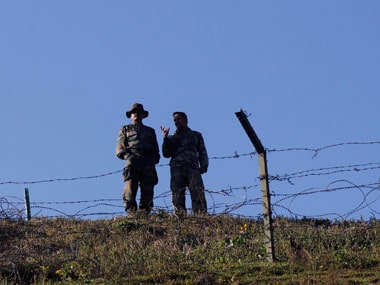Lashkar against Jaish! Who would have thought of it. No, the two most radicalised Pakistan-based, anti-India Jihadi groups are not engaged in an open battle with each other. But so intense is the infiltration of militants from various groups into India, that the two terror-sponsoring organisations have, during the past few weeks, been trying to elbow each other out of certain infiltration tracks leading into Kashmir. The best reputed guides on these tracks are in high demand, on each side; their rates must surely have increased. The latest infiltration bid was reported on Thursday afternoon, but such attempts have been frequent. The Army has sometimes combated three or more attempts simultaneously, at different points of the Line of Control. But this is the first time in several years that they have faced this level of challenge – or from such a variety of militant groups. [caption id=“attachment_2956010” align=“alignleft” width=“380”]  Representational image. Image courtesy/Firstpost[/caption] The most notable of the groups that is back in action is Jaish-e-Mohammed. Its militants have not been seen for several years now. The group was very active around 2001, but has been largely under wraps since President Musharraf acted to suppress it in 2002, after India amassed troops on the border. The group is even more radicalised than Lashkar-e-Taiba, which is run by Hafiz Sayeed. Jaish-e-Mohammed was founded by the similarly high-profiled Masood Azhar, who was released to the Taliban on the last day of 1999, along with two other prisoners, in exchange for the passengers of IC814 – the Indian Airlines aircraft that was hijacked to Kandahar, during a scheduled flight from Kathmandu. A ranking army officer confirms that both the terrorist groups have pushed in a large numbers of militants through established infiltration routes this summer. Not only that, the ingress continued through last winter. There was even a bid in December last, and more in February. The officer adds that Jaish has been trying to take control of some of the routes that Lashkar has used for the past few years. That’s not all. He says that other groups that have been inactive for several years now, have been sending in militants. Al Badr being one such group, for example. The Pakistan Army deployed along the Line of Control has given them cover fire. There was, for instance, an intense attack on the BSF’s Roshni post, a few months ago. Demonstrations give a cover for infiltration A former chief commander of a militant group, based in a village not far from the Line of Control, highlights another dimension of this trend: an extraordinary number of militants have infiltrated under the cover of the upsurge of demonstrations, stone-pelting and barricades by youth, over the past couple of months. His assertions carry weight, for he once headed a group that became Kashmir’s biggest for a while in the early 1990s. The upsurge of public anger in 2010, however, had not become a cover for infiltration. The Pakistan Army was preoccupied at the time with suppressing anti-Pakistan militancy on their north-western borders. However, there is a precedent for disturbed conditions elsewhere being used as a cover for large-scale infiltration. When army battalions posted across the Valley were hurriedly shifted to Kargil, to fight back the intruders there during the summer of 1999, security in the Valley had been left largely to the CRPF. Pakistan had used the opportunity to inject a large number of militants. That resulted in a couple of years of the most lethal proxy war waged in Kashmir since 1947-48. The phase began with a dramatic suicide attack at the main gate of Srinagar’s cantonment in December 1999. That was two months after General Musharraf usurped political power through a coup on 12 October, following a few months of friction between him and Prime Minister Nawaz Sharif, after the Kargil war. That lethal period of proxy war, which included frequent suicide attacks, continued for a couple of years. It only ended after India massed troops on the border in late December 2001. Masood Azhar, a ferocious rhetorician, had undertaken a virulent anti-India campaign across Pakistan not very long after the Kandahar hijack drama, at the close of 1999. His public meetings drew vast, enthusiastic audiences, from which he recruited cadres for Jaish-e-Mohammed. The ISI later sidelined Jaish, promoting Lashkar as its chief militant protégé. It seems ironic that another phase of major infiltration under cover of a diversion elsewhere in the state has brought Jaish and other long-dormant militant jihadist outfits to the fore again. Interesting times lie ahead.
Militants groups infiltrating into India, like Jaish and Lashkar, have been trying to elbow each other out of certain infiltration tracks into Kashmir.
David Devadas is an expert on politics and geopolitics. Formerly a Senior Fellow at the Nehru Memorial Museum and Library, Visiting Professor at Jamia Millia Islamia, and Political Editor of Business Standard, he is currently Distinguished Fellow at the Institute for Social Sciences. He has written books on Kashmir, on youth, and on history. He has been a radio compere, guest faculty at JNU's Academic Staff College, St Stephen's College and Hindu College. He has worked for the Indian Express, The Hindustan Times, India Today, The Economic Times and Gulf News. His most impactful article, on a murder cover-up, prevented a Congress President from becoming prime minister. One led to the closure of an airline, and another created a furore and consequent clean-up in Delhi's health department. Several have correctly predicted election results in key states, and a series of reports from Srinagar made the government aware of how unsettled the situation there was in 1990. He is an alumnus of St Xavier's School, St Stephen's College, and the Indian Institute of Mass Communication. He has lived for extended periods in Geneva and Berlin, and has traveled to almost 50 countries. He enjoys various kinds of music, theatre, design, architecture and art. see more


)

)
)
)
)
)
)
)
)



